
Transportation in the Philippines covers the transportation methods within this archipelagic nation of over 7,500 islands. From a previously underdeveloped state of transportation, the government of the Philippines has been improving transportation through various direct infrastructure projects, and these include an increase in air, sea, road, and rail transportation and transport hubs.
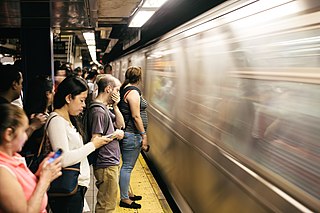
A rush hour or peak hour is a part of the day during which traffic congestion on roads and crowding on public transport is at its highest. Normally, this happens twice every weekday: once in the morning and once in the afternoon or evening, the times during which most people commute. The term is often used for a period of peak congestion that may last for more than one hour.

Epifanio de los Santos Avenue, commonly referred to by its acronym EDSA, is a limited-access circumferential highway around Manila, the capital city of the Philippines. It passes through 6 of Metro Manila's 17 local government units or cities, namely, from north to south, Caloocan, Quezon City, San Juan, Mandaluyong, Makati, and Pasay.

The Metropolitan Manila Development Authority is a government agency of the Philippines responsible for constituting the regional government of Metro Manila, comprising the capital city of Manila, the cities of Quezon City, Caloocan, Pasay, Mandaluyong, Makati, Pasig, Marikina, Muntinlupa, Las Piñas, Parañaque, Valenzuela, Malabon, Taguig, Navotas and San Juan, and the municipality of Pateros.

Road space rationing, also known as alternate-day travel, driving restriction and no-drive days, is a travel demand management strategy aimed to reduce the negative externalities generated by urban air pollution or peak urban travel demand in excess of available supply or road capacity, through artificially restricting demand by rationing the scarce common good road capacity, especially during the peak periods or during peak pollution events. This objective is achieved by restricting traffic access into an urban cordon area, city center (CBD), or district based upon the last digits of the license number on pre-established days and during certain periods, usually, the peak hours.

The transportation system in Metro Manila covers the road network, rail network, ferries, ports and airports located with the metropolitan Manila area. Road transportation in Metro Manila is diverse, composed of many types of private and public transport vehicles. These include taxis, buses, jeepneys, tricycles and pedicabs. In some areas, especially in Divisoria and large public markets, two-stroke motors are fitted in the pedicabs and are used for goods transport. Regardless of modernity, horse-drawn kalesas are still used in the streets of Binondo and Intramuros. Ridesharing services such as Grab also operate within in Metro Manila.

The Magallanes Interchange is a four-level partial turbine interchange in Makati, Metro Manila, Philippines, serving as the junction between the Osmeña Highway, Epifanio de los Santos Avenue (EDSA), and South Luzon Expressway (SLEX). It is also an interchange between the two train lines of Metro Manila, the MRT-3, which is over EDSA, and the PNR Metro Commuter Line beside Osmeña Highway and SLEX. It is currently one of the busiest intersections in Metro Manila.

Manuel L. Quezon Avenue, more often called as Quezon Avenue, or simply Quezon Ave, is a 6.1-kilometer (3.8 mi) major thoroughfare in Metro Manila named after President Manuel Luis Quezon, the second president of the Philippines. The avenue starts at the Quezon Memorial Circle and runs through to the Welcome Rotonda near the boundary of Quezon City and Manila.

Alabang–Zapote Road is a four-lane national road which travels east–west through the southern limits of Metro Manila, Philippines. It runs parallel to Dr. Santos Avenue in the north and is named for the two barangays that it links: Alabang in the city of Muntinlupa and Zapote in both the cities of Bacoor and Las Piñas.

The Ortigas Interchange, also known as the EDSA–Ortigas Interchange or the Ortigas Flyover, is a three-level partial stack interchange at the boundary between Mandaluyong and Quezon City in Metro Manila, the Philippines which serves as the junction between Epifanio de los Santos Avenue (EDSA) and Ortigas Avenue. Originally a regular four-way intersection, the current interchange was built in 1991 as the flagship infrastructure project of President Corazon Aquino.

The Makati Central Business District is a financial and central business district in the Philippines located in the heart of Makati in Metro Manila. It is politically known as "Central Cluster" in the West District of Makati. It is different from the Makati civic center known as "Makati Poblacion" which is situated at the northeast portion of the district. It is bounded by EDSA, Amorsolo Street, Ayala Avenue, Gil Puyat Avenue, Osmeña Highway, South Luzon Expressway, Metro Manila Skyway, Zobel Roxas Street, Ocampo Street, Metropolitan Avenue, Nicanor Garcia Street, Kalayaan Avenue, Makati Avenue, Anza Street, Polaris Street, Orion Street, Mercedes Street, Amapola Street and Estrella Street. The whole district occupies barangays of San Antonio, San Lorenzo, Bel-Air, and Urdaneta.

The Circumferential Road 5–Kalayaan Avenue Interchange, also known as the C-5–Kalayaan Interchange, is a road interchange in barangays West Rembo and East Rembo in Taguig, Metro Manila. Originally a regular four-way intersection between Carlos P. Garcia Avenue, a part of Circumferential Road 5 (C-5), and Kalayaan Avenue, it was fitted in 2009 with the country's first elevated U-turn slots, built in an attempt to speed up traffic along the C-5 corridor.
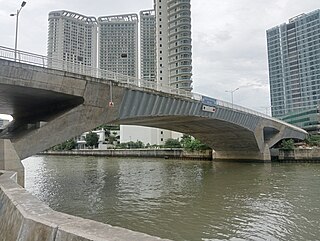
The Estrella–Pantaleon Bridge, also known as the Rockwell Bridge, is a four-lane box girder bridge crossing the Pasig River in Metro Manila, Philippines. It connects Estrella Street in Makati on the south bank of the Pasig River, to Pantaleon Street via Barangka Drive in Mandaluyong on the north bank, near the site of the Acqua Private Residences.

The Estrella Flyover, also known as the EDSA–Estrella Ramp and the Rockwell Flyover, is a two-lane flyover connecting Epifanio de los Santos Avenue (EDSA) and Estrella Street in Makati, Metro Manila, the Philippines, facilitating access to the Rockwell Center mixed-use development. It runs along the barangay boundary of Bel-Air with Pinagkaisahan and Guadalupe Viejo.

The President Sergio Osmeña Sr. Highway, also known as the South Superhighway, is a 4.595-kilometer (2.855 mi) major highway that links Quirino Avenue in Paco, Manila to Epifanio de los Santos Avenue (EDSA) and South Luzon Expressway (SLEX) at the Magallanes Interchange in Makati.
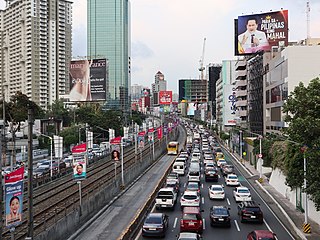
According to a "Global Driver Satisfaction" survey conducted by the navigation app Waze in 2015, Metro Manila had the "worst traffic on Southeast Asia". Emerson Carlos, MMDA assistant general manager for operation has mentioned that in 2015, motor vehicle registrations in Metro Manila peaked at around 2.5 million.
The Santa Rosa Integrated Terminal (SRIT), also known as the SM City Santa Rosa Transport Terminal, is a bus station in SM City Santa Rosa in Santa Rosa, Laguna, Philippines. It is the second of three planned provincial intermodal terminals for the south of Manila under a public-private partnership arrangement. Opened on March 26, 2019, the terminal handles province-bound and incoming buses from Calabarzon and the Bicol Region, as well as other provincial buses plying the nautical highway in the south pending the completion of, and as an alternative to, the Taguig Integrated Terminal Exchange.
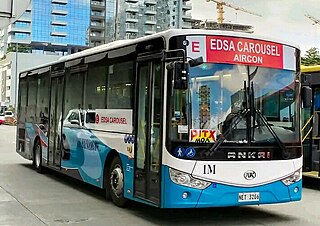
The EDSA Carousel, also known as Route 1 and formerly and still referred to as Route E, is a bus rapid transit (BRT) system, part of several bus routes in Metro Manila. It is situated along EDSA and other roads, running on a dedicated right-of-way called the EDSA Busway, separated from normal road traffic in most of its stretch by concrete barriers and steel bollards on the innermost lane.

The No Contact Apprehension Policy (NCAP) refers to different active traffic management and road traffic safety measures being implemented by local government units all over the Philippines.
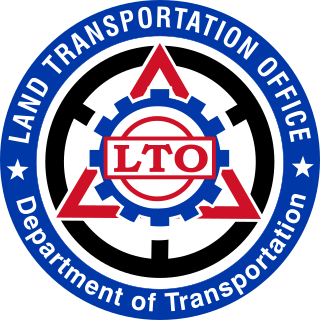
Traffic law in the Philippines consists of multiple laws that govern the regulation and management of road transportation and the conduct of road users within the country.


















